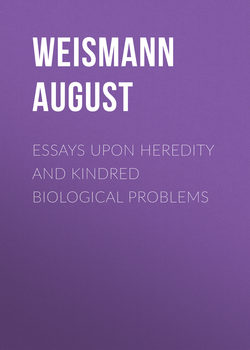Читать книгу Essays Upon Heredity and Kindred Biological Problems - Weismann August - Страница 5
I.
THE DURATION OF LIFE.
1881
APPENDIX
Note 1. The Duration of Life among Birds
ОглавлениеThere is less exact knowledge upon this subject than we might expect, considering the existing number of ornithologists and ornithological societies with their numerous publications. It has neither been possible nor necessary for my purpose to look up all the widely-scattered references which are to be found upon the subject. Many of these are doubtless unknown to me; for we are still in want of a compilation of accurately determined observations in this department of zoology. I print the few facts which I have been able to collect, as a slight contribution towards such a compilation.
Small singing birds live from eight to eighteen years: the nightingale, in captivity, eight years, but longer according to some writers: the blackbird, in captivity, twelve years, but both these birds live longer in the natural state. A ‘half-bred nightingale built its nest for nine consecutive years in the same garden’ (Naumann, ‘Vögel Deutschlands,’ p. 76).
Canary birds in captivity attain an age of twelve to fifteen years (l. c., p. 76).
Ravens have lived for almost a hundred years in captivity (l. c., Bd. I. p. 125).
Magpies in captivity live twenty years, and, ‘without doubt,’ much longer in the natural state (l. c., p. 346).
Parrots ‘in captivity have reached upwards of a hundred years’ (l. c., p. 125).
A single instance of the cuckoo (alluded to in the text) is mentioned by Naumann as reaching the age of thirty-two years (l. c., p. 76).
Fowls live ten to twenty years, the golden pheasant fifteen years, the turkey sixteen years, and the pigeon ten years (Oken, ‘Naturgeschichte, Vögel,’ p. 387).
A golden eagle which ‘died at Vienna in the year 1719, had been captured 104 years previously’ (Brehm, ‘Leben der Vögel,’ p. 72).
A falcon (species not mentioned) is said to have attained an age of 162 years (Knauer, ‘Der Naturhistoriker,’ Vienna, 1880).
A white-headed vulture which was taken in 1706 died in the Zoological Gardens at Vienna (Schönbrunn) in 1824, thus living 118 years in captivity (l. c.).
The example of the bearded vulture, mentioned in the text, is quoted from Schinz’s ‘Vögel der Schweiz,’ p. 196.
The wild goose must live for upwards of 100 years, according to Naumann (l. c., p. 127). The proof of this is not, however, forthcoming. A wild goose which had been wounded reached its eighteenth year in captivity.
Swans are said to have lived 300 years(?), (Naumann, l. c., p. 127).
It is evident that observations upon the duration of life in wild birds can only rarely be made, and that they are usually the result of chance and cannot be verified. It is on this account all the more to be desired that every ascertained fact should be collected.
If the long life of birds has been correctly interpreted as compensation for their feeble fertility and for the great mortality of their young, it will be possible to estimate the length of life in a species, without direct observation, if we only know its fertility and the percentage of individuals destroyed. This percentage can, however, at best, be known only as an average. If we consider, for example, the enormous number of sea birds which breed in summer on the rocks and cliffs of the northern seas, and if we remember that the majority of these birds lay but one, or at most two eggs yearly, and that their young are exposed to very many destructive agencies, we are forced to the conclusion that they must possess a very long life, so that the breeding period may be many times repeated. Their number does not diminish. Year after year countless numbers of these birds cover the rocks, from summit to sea line; millions of them rest there, and rise in the air like a thick cloud whenever they are disturbed. Even in those localities which are every year visited by man in order to effect their capture, the number does not appear to decrease, unless the birds are disturbed and are therefore prompted to seek other breeding-places. From the small island of St. Kilda, off Scotland, 20,000 young gannets (Sula) and an immense number of eggs are annually collected; and although this bird only lays a single egg yearly and takes four years to attain maturity, the numbers do not diminish6. 30,000 sea-gulls’ eggs and 20,000 terns’ eggs are yearly exported from the breeding-places on the island of Sylt, but in this case it appears that a systematic disturbance of the birds is avoided by the collectors, and no decrease in their numbers has yet taken place7. The destruction of northern birds is not only caused by man, but also by various predaceous mammals and birds. Indeed the dense mass of birds which throng the cliffs is a cause of destruction to many of the young and to the eggs, which are pushed over the edge of the rocks. According to Brehm the foot of these cliffs is ‘always covered with blood and the dead bodies of fledglings.’
Such birds must attain a great age or they would have been exterminated long ago: the minimum duration of life necessary for the maintenance of the species must in their case be a very high one.
6
Oken, ‘Naturgeschichte,’ Stuttgart, 1837, Bd. IV. Abth. 1.
7
Brehm, ‘Leben der Vögel,’ p. 278.
